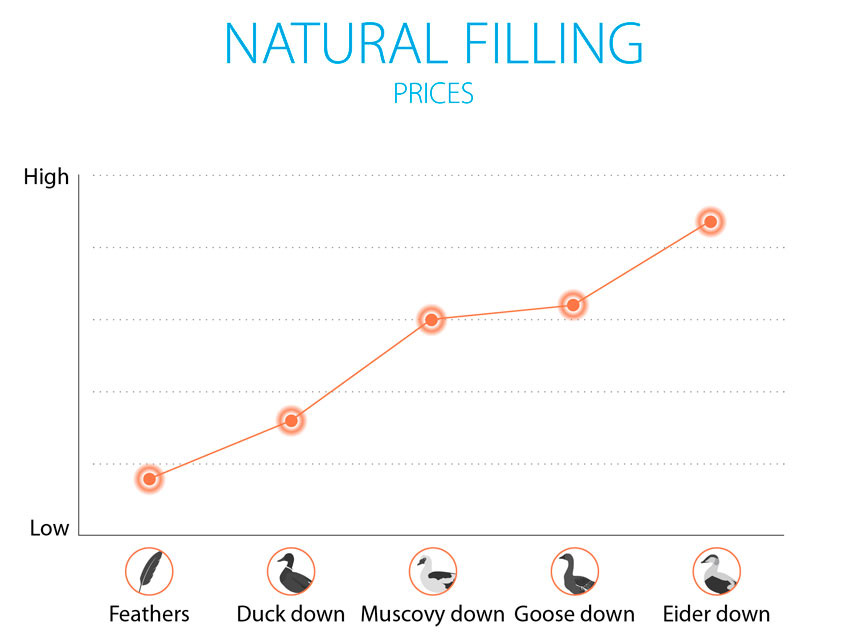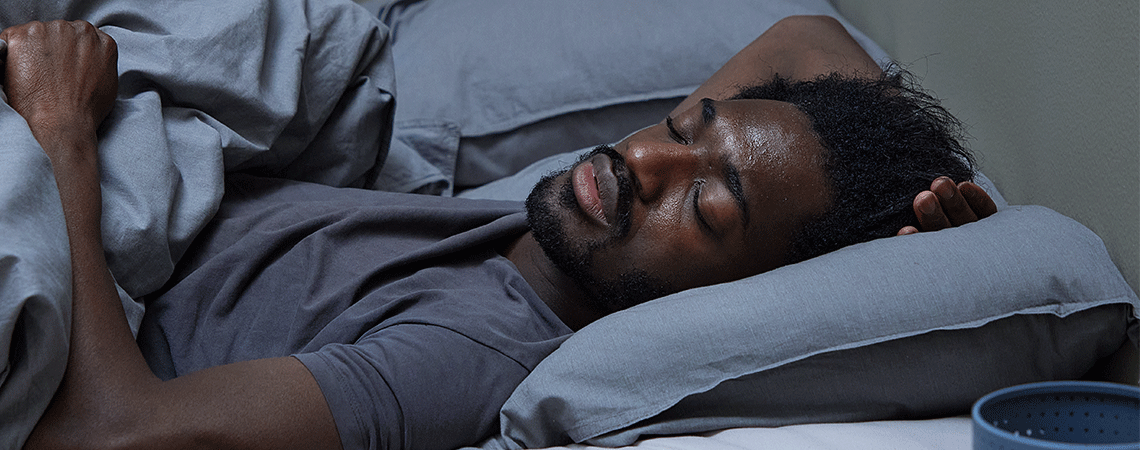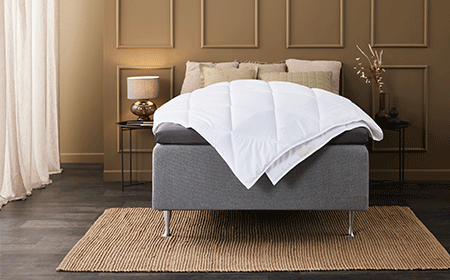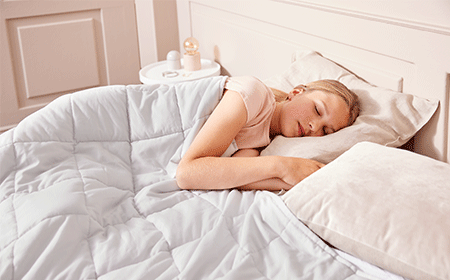The price of a duvet reflects the quality of the fabric and the filling, and you can buy duvets at many different price levels. In this guide, you can learn more about the relationship between price and quality and find answers to some of the most common questions that arise when purchasing a duvet:
- What are the quality ranges that JYSK duvets are divided into?
- What are the main differences between BASIC, PLUS, and GOLD duvets?
- How does the duvet's filling affect its price?
- Does a duvet's price reflect its durability and longevity?
- If I spend more money on a duvet, will I be able to feel the difference?
Which quality ranges are duvets divided into in JYSK?
Besides the duvet cost, the first step toward finding the duvet that matches your budget is to consider the three quality ranges that we use to classify duvets in JYSK: BASIC, PLUS, and GOLD.
Single duvets | Fibre filling | Natural filling |
BASIC | ||
PLUS | ||
GOLD |
What are the differences between duvets in the three quality ranges?
Regardless of whether you want a duvet with fibre or natural filling, you'll be able to choose between a BASIC, PLUS or GOLD model. They differ from each other in several ways.
The BASIC quality range
In this quality range, you will find JYSK's best duvet prices and overall most affordable duvets that give you great value for your money. The BASIC quality range is for those seeking a great bargain who aren’t necessarily interested in premium or high-end features. Many of our BASIC duvets are part of our EVERYDAY LOW PRICE category, which means they are always sold at a fixed low price.
The PLUS quality range
The PLUS category is where you'll find a quality duvet at an affordable price. The duvets in PLUS are more exclusive than those found in BASIC because they include a number of additions that increase their overall quality:
- A more durable cover
- High-quality fibre filling in fibre duvets
- A higher down percentage in the feather/down mix of natural duvets
With the purchase of any PLUS duvet, you always get a five-year guarantee.
The GOLD quality range
In the GOLD quality range, you'll find our most exclusive high-end duvets. When you go from PLUS to GOLD, you'll get a number of additional features, resulting in a higher price but naturally also improvements to the overall quality, comfort, and longevity of the duvet.
- The cover is made from materials of the highest quality
- For fibre duvets, the filling is made from fibres created through more advanced technology. For example, the filling may have underdone additional treatments for various benefits.
- For natural duvets, the GOLD-quality ones, compared to similar ones in the PLUS category, generally contain a higher percentage of down in their filling
With the purchase of any GOLD duvet, you always get a ten-year guarantee.
How does a duvet's filling affect its price?
Quality and price go hand in hand. In order to make sense of the duvet price, it's important to know about the most common types of filling in natural and fibre duvets. The origin of the feathers or down in combination with the quality are what decides the price, but as a rule of thumb, a duvet with a high percentage of eiderdown costs more than a duvet with a high percentage of feathers or duck down.

The chart above is meant to depict that some types of natural filling are more costly than others. Material prices fluctuate over time, and the points on the chart are indicative only. The final price of a duvet with natural filling with depend on several factors, but most importantly the particular filling mix used for the duvet.
- Feathers
Feathers are a natural material with lower insulating power. A high number of feathers results in a relatively heavy duvet, which is preferred by some people. - Duck down
Duck down is soft and has good insulating properties. - Muscovy down
Muscovy down is soft and has great insulating properties. - Goose down
Goose down has great insulating properties and contributes to a soft and airy duvet. - Eiderdown
Eiderdown offers unmatched warmth with incredible lightness. The down traps air for exceptional insulation, while remaining unbelievably soft and breathable for a luxurious experience.
Feathers and duck down make up the most common filling in affordable, value-for-money natural duvets on the market. For high-end natural filling, look for Muscovy down, goose down, and eiderdown.
" Like common ducks, eider ducks are not raised domestically. To get their down, you’ll have to gather it from their nests along rocky shorelines in northern latitudes."
– Berit, Category Manager, JYSK
Down is always more expensive than feathers and only the most exclusive high-end duvets are filled with 100% down. In more affordable duvets, the filling often is made of a combination of down and feathers.
Fibre filling
Fibre filling is available in different qualities.
- Two-dimensional fibres
Standard fibre filling is what is known as two-dimensional fibres. Two-dimensional fibre filling is an affordable, commonly used material for duvets. - Three-dimensional fibres
Three-dimensional fibres are also called hollow fibres. In JYSK, our hollow fibres come in three versions: One-hole, three-hole, and seven-hole. Air fills the holes and thus increases the filling's insulation properties.
The higher quality duvets and fibre filling you go, the more advanced filling you get. In addition to going from two to three-dimensional fibres, you can also choose fibre filling with additional finishing treatment. For example, some fibres have been siliconised, which makes them smoother and less likely to clump together.
What impact does duvet price have on its lifespan?
In JYSK, the purchase of any duvets comes with a guarantee. Duvets in the PLUS quality range come with a five-year guarantee, and with the purchase of a GOLD duvet, you'll get a ten-year guarantee.
The length of the guarantee reflects how long – with normal use – the expected longevity of the duvet is. In other words, you're likely to get a duvet that will last longer if you go a step or two up in duvet price and thus quality.
"The lifespan depends a lot on how you use and handle your duvet. Do you remember to regularly air out your bedroom? Do you let your duvet dry properly or do you put a bed throw on right away? These are the types of things that can affect the long-term durability of both fibre and natural duvets."
– Berit, Category Manager, JYSK
Can I feel the difference between an expensive duvet and a lower-priced one?
Yes, you can feel the difference between duvets of different quality ranges. High-quality duvets often feel softer and airier than their lower-priced alternatives. Category Manager Berit also points out that in some cases, you'll also find that the material in the costliest duvets is more flexible, allowing the duvet to better fit the shape of your body.
If you're looking for a natural duvet, you can test the difference between the various types by pressing down on the filling and moving your hands across the duvet. The high-quality filling will quickly rebound to its original shape while lower-priced options will take longer. It's this ability to reshape that makes the duvet feel so airy.




